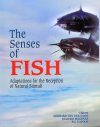By: Gerhard von der Emde(Editor), Joachim Mogdans(Editor), BG Kapoor(Editor)
377 pages, Col photos, b/w photos, figs
![The Senses of Fish The Senses of Fish]()
Click to have a closer look
About this book
Contents
Customer reviews
Related titles
About this book
Fish comprise more than 50% of all living vertebrates and are found in a wide range of highly diverse habitats like the deep sea, the shoreline, tide pools, tropical streams and sweetwater ponds. During evolution, the senses of fish have adapted to the physical conditions of the environment in which different species live. As a result, the senses of fish exhibit a remarkable diversity that allows different species to deal with the physical constraints imposed by their habitat. In addition, fish have evolved several `new' sensory systems that are unique to the aquatic environment.
In this book, examples of adaptation and refinement are given for six sensory systems: The visual system, The auditory system, The olfactory system, The mechanosensory lateral line system, The taste system, The electrosensory system. In each case, the environmental conditions under which a particular group of fish lives are analyzed. This is followed by a description of morphology and physiology of the sensory system and by an evaluation of its perceptional capabilities. Finally, the sensory adaptations to the particular conditions that prevail in the habitat of a species are highlighted.
The various examples from different groups of fish presented in this book demonstrate the impressive capability of fish sensory systems to effectively overcome physical problems imposed by the environment.
Contents
1. A Fish's Eye View of Habitat Change
2. The Photoreceptors and Visual Pigments of Sharks and Sturgeons
3. Chemosensory Systems in Fish: Structural, Functional and Ecological Aspects
4. Taste and Olfactory Stimuli and Behavior in Fish
5. Olfactory Imprinting in Salmon: New Models and Approaches
6. Sensory Brain Areas in Deep Sea Slickheads, Eels, and Grenadiers: Comparison of Mesopelagic and Demersal Species
7. Neural Mechanisms of Hearing in Fish
8. Neuroethology and Sensory Ecology of Teleost Ultrasound Detection
9. The Role of Gas-Holding Structures in Fish Hearing: An Acoustically Evoked Potentials Approach
10. Sound Production and Acoustic Communication
11. Lateral Line Sensory Ecology
12. Neurobiology of the Fish Lateral Line: Adaptations for the Detection of Hydrodynamic Stimuli in Running Water
13. Adaptation of the Rostral Ampullary Electrosense for Plankton Feeding by the Paddlefish
14. Ecological Functions and Adaptations of the Elasmobranch Electrosense
15. Electroreception: Strategies for Separation of Signals from Noise
16. Essay: The Lure of Field Research on Electric Fish
Customer Reviews
By: Gerhard von der Emde(Editor), Joachim Mogdans(Editor), BG Kapoor(Editor)
377 pages, Col photos, b/w photos, figs


































